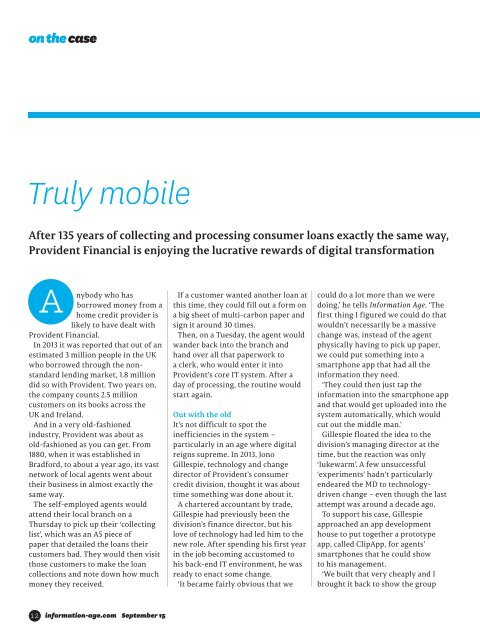A NEW BREED
1LxhtJc
1LxhtJc
- No tags were found...
You also want an ePaper? Increase the reach of your titles
YUMPU automatically turns print PDFs into web optimized ePapers that Google loves.
on the case<br />
Truly mobile<br />
After 135 years of collecting and processing consumer loans exactly the same way,<br />
Provident Financial is enjoying the lucrative rewards of digital transformation<br />
A<br />
nybody who has<br />
borrowed money from a<br />
home credit provider is<br />
likely to have dealt with<br />
Provident Financial.<br />
In 2013 it was reported that out of an<br />
estimated 3 million people in the UK<br />
who borrowed through the nonstandard<br />
lending market, 1.8 million<br />
did so with Provident. Two years on,<br />
the company counts 2.5 million<br />
customers on its books across the<br />
UK and Ireland.<br />
And in a very old-fashioned<br />
industry, Provident was about as<br />
old-fashioned as you can get. From<br />
1880, when it was established in<br />
Bradford, to about a year ago, its vast<br />
network of local agents went about<br />
their business in almost exactly the<br />
same way.<br />
The self-employed agents would<br />
attend their local branch on a<br />
Thursday to pick up their ‘collecting<br />
list’, which was an A5 piece of<br />
paper that detailed the loans their<br />
customers had. They would then visit<br />
those customers to make the loan<br />
collections and note down how much<br />
money they received.<br />
If a customer wanted another loan at<br />
this time, they could fill out a form on<br />
a big sheet of multi-carbon paper and<br />
sign it around 30 times.<br />
Then, on a Tuesday, the agent would<br />
wander back into the branch and<br />
hand over all that paperwork to<br />
a clerk, who would enter it into<br />
Provident’s core IT system. After a<br />
day of processing, the routine would<br />
start again.<br />
Out with the old<br />
It’s not difficult to spot the<br />
inefficiencies in the system –<br />
particularly in an age where digital<br />
reigns supreme. In 2013, Jono<br />
Gillespie, technology and change<br />
director of Provident’s consumer<br />
credit division, thought it was about<br />
time something was done about it.<br />
A chartered accountant by trade,<br />
Gillespie had previously been the<br />
division’s finance director, but his<br />
love of technology had led him to the<br />
new role. After spending his first year<br />
in the job becoming accustomed to<br />
his back-end IT environment, he was<br />
ready to enact some change.<br />
‘It became fairly obvious that we<br />
could do a lot more than we were<br />
doing,’ he tells Information Age. ‘The<br />
first thing I figured we could do that<br />
wouldn’t necessarily be a massive<br />
change was, instead of the agent<br />
physically having to pick up paper,<br />
we could put something into a<br />
smartphone app that had all the<br />
information they need.<br />
‘They could then just tap the<br />
information into the smartphone app<br />
and that would get uploaded into the<br />
system automatically, which would<br />
cut out the middle man.’<br />
Gillespie floated the idea to the<br />
division’s managing director at the<br />
time, but the reaction was only<br />
‘lukewarm’. A few unsuccessful<br />
‘experiments’ hadn’t particularly<br />
endeared the MD to technologydriven<br />
change – even though the last<br />
attempt was around a decade ago.<br />
To support his case, Gillespie<br />
approached an app development<br />
house to put together a prototype<br />
app, called ClipApp, for agents’<br />
smartphones that he could show<br />
to his management.<br />
‘We built that very cheaply and I<br />
brought it back to show the group<br />
12 information-age.com September 15


